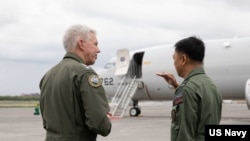The South China Sea has seen an increase in military activity in recent weeks.
The U.S. and its allies conducted several joint military exercises near the Philippines. The drills come amid growing regional tension following the latest territorial standoff between China and the Philippines earlier in August.
Analysts say Washington and its allies are showcasing an “inter-alliance cohesion” through these coordinated activities.
“What I think the U.S. would like to do is to send China a message that the alliance is in lockstep with each other,” Euan Graham, senior analyst at the Australian Strategic Policy Institute, told VOA in a phone interview.
Forces from Australia, the Philippines, and the United States conducted a series of military exercises beginning Aug. 21, carrying out mock beach landing and air assault maneuvers in areas near the South China Sea. It’s the largest military drill involving Canberra and Manila, which are both critical of Beijing’s increasingly aggressive posture in the disputed water.
In addition to the trilateral exercises, the Japanese Defense Ministry shared that Japan, Australia, the United States, and the Philippines held joint naval drills on Aug. 24.
Following the joint exercises, military leaders from the four countries held talks in Manila.
In a statement, U.S. 7th Fleet commander Vice Adm. Karl Thomas characterized the joint efforts as a commitment to "maintaining peace and stability in the Indo-Pacific region while adhering to the Law of the Sea."
U.S.-led deterrence could make China more "confrontational"
After the Philippines accused Chinese coast guard ships of spraying Filipino supply vessels with water cannons in early August, some observers said the U.S.-led efforts to increase its presence in the South China Sea were to uphold the rules-based order.
"These drills are the U.S. and its like-minded partners’ way of exercising deterrence against China," Eleanor Hughes, a nonresident fellow at the Chicago-based research and policy analysis organization Econvue, told VOA in a Zoom interview.
While Washington and its allies hope to shift China's aggressive behaviors in the South China Sea through deterrence and other means, some defense experts say Beijing may view these moves as an intensification of U.S.-led efforts to contain it.
"I think the U.S. and its partners are trying to shift China’s behavior for the better, but my concern is how can they do it to the extent in which they wouldn’t push China to the corner," Collin Koh, a defense scholar at Singapore's S. Rajaratnam School of International Studies, explained to VOA.
He adds that some developments in recent years suggest China could be pushed to adopt a more confrontational approach. As Beijing struggles to address unprecedented domestic political and economic problems, Koh thinks China may adopt what he describes as "a policy of externalization," where authorities try to distract the public from domestic challenges.
"China could undertake more confrontational and more aggressive actions with respect to flashpoints like the South China Sea or even Taiwan," he said. "I don’t think that’s what the U.S. and its allies want to achieve."
Commenting on the water cannon incident, the commander of the U.S. Navy's 7th Fleet Vice Adm. Karl Thomas said on Aug. 27 that China's aggressive behavior in the South China Sea must be challenged and checked.
"There's no better example of aggressive behavior than the activity on 5 August on the shoal," Thomas said. "You have to challenge people I would say operating in a grey zone."
In response, Chinese Foreign Ministry spokesperson Wang Wenbin said U.S. warships have been flexing muscles and sowing discord in the disputed water, which qualifies as "aggressive behavior."
"China Coast Guard takes necessary measures to safeguard China's sovereignty and maritime rights and interests," he said during the daily press briefing on Aug. 28. "This is beyond reproach. The US has no right to interfere."
China claims almost all of the South China Sea, an assertion rejected internationally, and Malaysia, Vietnam, Brunei, Taiwan, and the Philippines have various claims to certain areas.
South Korea may look to become more involved in the South China Sea
Apart from efforts to establish deterrence through joint military drills with partners in the South China Sea, some analysts say South Korea, another key U.S. ally in the Indo-Pacific region, may be setting its sights on being more involved in Southeast Asia.
"For the most part, Seoul has been quite quiet when it comes to the South China Sea, but in recent times, this seems to have changed," said Singapore-based defense expert Koh. "Following the water cannon incident, the Korean embassy in Manila issued a statement criticizing China. It’s quite rare for the Koreans to be so open about it."
While Seoul’s level of commitment to the South China Sea remains unclear, Koh thinks some signs suggest South Korea may want to be more visible in Southeast Asia, with the South China Sea in mind. "There is a more robust set of alliance relationships that underpin the U.S. approach in the South China Sea against China," he told VOA.
For the most part, analysts think Beijing, Washington, and its allies will continue to keep their activities in the South China Sea "under the threshold of an armed conflict." However, they say Beijing will continue to press its claims over the South China Sea.
"If they don’t have success against Manila, they will probably try Vietnam, and if Vietnam pushes back, they might try Malaysia," said Graham from Australian Strategic Policy Institute. "There are many opportunities for Beijing to press its claims. That’s why the most important challenge is to get a cohesive response not just from the U.S. allies but also from Southeast Asian countries.”








